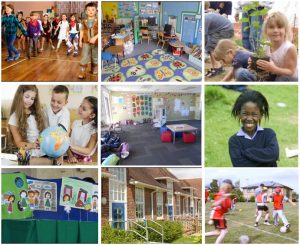How do schools deploy their websites to represent the experiences of learning to the communities they serve?
Taking a picture is a possible metaphor for doing research. Metaphors can be misleading but sometimes they help us think more carefully about what is getting mirrored – ‘doing research’ in this case. For instance, consider how a photographer uses ‘depth of field’. This is about focus: how far some feature in a scene is rendered with sharpness of presence, but at the expense of its background. In this picture we see a cat but not really its surroundings, not its context, not its ecology.

Research on learning can, by analogy, address its topic with such a ‘shallow focus’ – closely inspecting some curricular learning episode while setting matters of context aside. However, the more ‘deep-focussing’ research project will explore learning holistically – considering the wider context in which individual learning episodes are embedded.
One perspective that a holistic framework adopts is an understanding that what students take away from schooling – what gets learned – doesn’t only arise in these formal curricular episodes. A school also supports an informal (perhaps “hidden”) curriculum. This is shaped within a ‘local culture’: the home-grown rituals, rules, values and practices of a particular school, but also its resources, tools, and spaces for interacting. How can we evaluate such environments, when adopting this more generous, or holistic, conception of a child’s learning experience? How can we get such a community-of-learning into a usefully deep focus?
Making the culture of learning visible
The questions posed above are certainly challenging. Progress on them is dependent on the accumulation of outcomes from many individual research studies. Accordingly, the project summarised here only sought one small increment to that understanding. It raised the narrower question: “how do primary schools make their cultures of learning visible?”. An audience for such visibility is, of course, the families and carers of pupils. One significant motive for reaching them is the imperative for parental engagement. It therefore seemed useful to research how schools represented learning, not least because of its role in shaping parental expectations.
A comprehensive, yet accessible, window onto a school is its website. These sites can make learning visible to parents – and potential parents. Moreover, they are increasingly scrutinised by inspection agencies – in the wake of government requirements that they should disseminate key information. They are, therefore, a priority to get right and, not surprisingly, an industry of design companies has sprung up to help.
Yet there is very little research on design strategy (or its impact) as related to these ‘windows’. While the policy, curriculum and mission documents that are posted there may attract some attention, it is surely visual material that conveys the most compelling impression of a culture-of-learning. To explore this, we randomly selected 150 primary school websites and sorted the images we found on them into categories. The purpose was to use this image profile to capture how the experience of learning was being expressed to a wider world.
This exercise creates a large portfolio of images – and a challenge of qualitative analysis! The themes that emerge can not confidently summarise what the experience of learning is actually like in this sector (that requires close and on-site researcher presence). But they can summarise how the sector itself wishes to express the experience of learning – to outside observers. Indeed, these representations may be significant in shaping popular thinking about the conditions and character of schooled learning.
Finding a picture taxonomy
The rich array of pictures that were captured this way can be simplified around three themes – summarised here in order of prominence. First, the two most common categories of image expressed the quality of the learning community: in terms of ‘places’ and ‘personalities’. Images depicting the material environment show welcoming areas that are reassuringly human in scale and décor (rather than boasting specialist facilities or technologies). While close-up images of individual pupils express a different kind of community reassurance: diversity and sunny dispositions. Together, we can assume these most frequent images offer a comforting promise regarding the supportive shell within which learning will happen.

The second most prevalent theme might be termed ‘activity centred’. Here, images that projected exercise were the third most commonly found category: sport, games, gym etc. Activity was also stressed in the fourth most common category: namely, pictures from school off-site trips. Finally, and close behind, were pictures of school performances: dance, theatre etc. Together, this family of images illustrate the corporate nature of educational experience. But they may also stress a reassuring continuity between out-of-school and in-school pleasures and lifestyle.
The third theme can be called ‘study’. These were images that communicated traditional notions of schooled learning. Yet they were relatively scarce in this collection. We broke them down into categories depicting episodes of teacher-led instruction, private reading, writing or use of computers. Each of these were present in only around one third of the sites. Although much more common were images that depicted study through ‘making’ or drawing (68% of sites).
Inviting young learners to talk about their school day is notoriously difficult. Resources that visually express how learning is embedded in practices of schooling are therefore useful. It can be said that the websites explored here project a model of the learning environment that is participative, collegial, animated and warm. Arguably, a context that is continuous with the atmosphere of idealised homelife. While in learning theory terms, these images of independent and exploratory activity might imply a strong agenda of constructivism. Perhaps consistent in respecting that tradition, more conventionally academic or didactic scenarios of learning (instruction, reading, writing, computer work) were scarce. Indeed, teachers in action were very rarely depicted.
Reflection
The summarising notes here are drawn from a ‘deep focus’ exploration of learning – as represented by schools themselves. The project only demanded attention to images, but any such immersion in websites prompts reflection that goes beyond the visual alone. One overarching thought that arises is that a website has great potential for knitting schooled activity not only into families but also into the wider community. Towards which possibility, the following suggestions come to mind:
- Images are too often left to speak for themselves. Yet rewards arising from the activities depicted could be articulated with text commentary, or integrated with the details of mission statements or the curriculum.
- Images could be less shy about the actual practices of teachers, those acts of instruction – particularly as they might show the scaffolding of learning through teachers’ acts of close observation and feedback.
- Many outcomes of pupil work are often image-friendly: websites could celebrate them more vigorously.
- Moreover, such ‘galleries’ could document an historical trail of learning and achievement: one that could provide models, challenges and inspiration to each new generation of students.
- Outreach: a school website could become a beacon of information, talent, and local history serving the surrounding community – incidentally rendering pupils as journalists, researchers and curators.
[A .pdf file of this article can be downloaded here]
Authored by:
Charles Crook is Emeritus Professor of Education and a member of the Learning Sciences Research Institute at the University of Nottingham

Leave a Reply